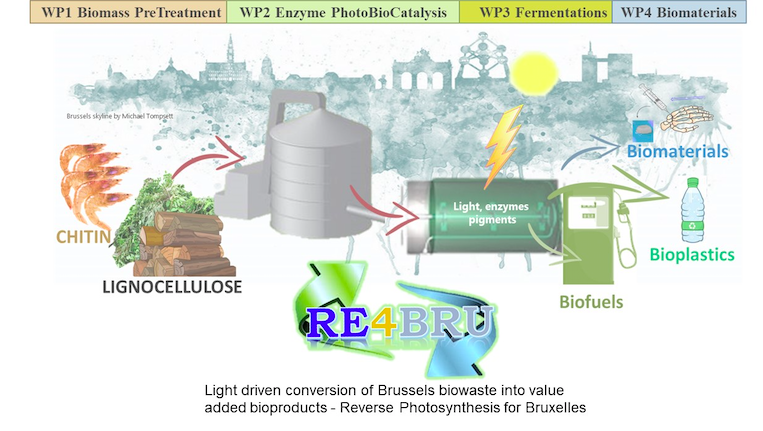Dans la même rubrique
- Crop Nutrition Unit
-
Photobiocatalysis Unit
- David Subject 1
- David Subject 2
- Publications
- Collaborations
- Current Projects
- 01-2025 > 12-2028
Reaching the core of the circadian clock in plant roots : implications for root morphology and nutrient uptake
Research project (PDR) F.R.S.-FNRS
C. Hermans
The aim iof this project s to understand how the root and shoot circadian clocks communicate with one another, to coordinate rhythms at the whole plant level and ensuring timely physiological events. The focus is on the natural and induced variations of root clock properties in Arabidopsis thaliana, and their impact on root morphology and the transport of mineral elements.
- 01-2024 > 12-2025
Natural variation in cereal C4 crops to enhance resilience to soil resources limitation
Research credit (CR) F.R.S.-FNRS
C. Hermans
The root system provides a highly dynamic network to access the heterogeneously distributed nutrient and water resources in soil. Root traits have been poorly considered in breeding programs, but they are now recognized as a lever to help crops coping with poor soil fertility and drought. Root and shoot phenotyping, as well as genetic mapping approaches are employed to identify chromosomic regions and candidate genes underlying the response to nitrogen and water stresses. The candidate genes are validated via transcriptomic techniques.
-
04-2021 > 12-2024
C4FUTURE - Fortifying and Enhancing Resilience in C4 Crops for Current and Future Climate Change Adversities
SusCrop-ERA-NET Cofund on Sustainable Crop Production
Coordination: C. Hermans
In the face of escalating climate challenges, the sustainability of agriculture, food security, and social stability are at risk. Increasing temperatures, greater aridity, and more frequent extreme weather events are pressing issues that demand immediate attention. An important issue facing the agricultural community is increasing crop resilience to climate changes. Earth will increasingly favour C4 plants like maize and sorghum (a niche crop in Europe that is high in antioxidants and gluten-free), as carbon dioxide levels rise. These two cereals
will become crucial for human sustenance in the future. C4FUTURE is leveraging natural variation in large diversity panels of these two species to enhance crop adaptation to nitrogen and water limitations, two major constraints on crop productivity that are predicted to worsen. This research spans laboratory settings and open-fields to ascertain the functional trait plasticity and to develop superior C4 cereal ideotypes. Mapping approaches are employed to identify genetic components that contribute to resilience towards climate changes.

-
2020 > 2025
EnLighten Me - Enabling with light enzymes and metals - a global approach for the activation of carbon dioxide and methane
Action de Recherche concertée (ARC)
Coordination: G. Evano, Dpt Organic Chemistry and Physico-Chemistry, Faculty of Sciences
Partners: C. Moucheron, Dpt Organic Chemistry and Physico-Chemistry; D. Cannella
Carbon dioxide and methane are the two main greenhouse gases, and they are being released at dramatically increasing rates. This means there is an obvious and significant need to reduce emissions of these gases; transforming them into easily usable chemicals is one of the most attractive options for this. However, for this to be useful, the processes implemented must be sustainable and efficient in terms of both costs and energy consumption. This is the context in which ARC project ENLIGHTEN ME was started, with a view to developing innovative and efficient processes for the transformation and use of carbon dioxide and methane based on a comprehensive approach, using metal and enzyme catalysts that are simply activated by light.
Links: https://www.ulb.be/fr/arc/arc-research-project-enlighten-me

-
2019 > 2022
RE4BRU - Light driven conversion of Brussels biowaste into value added bioproducts - Reverse Photosynthesis for Bruxelles
Innoviris-Bridge
Coordination: D. Cannella
Partners: T. Doneux, Chemsin, Faculty of Sciences - ULB; A. Shavandi, Biomatter - EPB ULB; I. Cybulska and P. Gerin Bioengineering & Biorefining, UCLouvain
Private-public parrains: Galatic; Bruxelles.HUB; Bruxelles.Environment
Plant derived waste and seafood-wastes are abundant renewable bioresources on Earth and in the Brussels Capital Region too. These bioresources are rich in polysaccharides an attractive source of bio-based green chemicals, materials and biofuels. The aim of RE4BRU project is to valorise these bioresources sorted from Brussels, using innovative green conversion technologies set upon a newly discovered “Reverse Photosynthesis” photo-biocatalysis. This technology uses redox depolymerizing enzymes powered by Light through excited photoelectrons coming from photosynthetic pigments. These photosensitizer like chlorophyll are naturally sorted and represent the core of this technology being further developed at the PhotoBioCatalysis and ChemSIN research groups at ULB. The innovative valorization of the lignocellulose that will be investigated involves also the extraction of lignin under more environmentally friendly conditions and electro-fermentation done by the Bioengineering&Biorefining team at UCL, whereas sugar fermentation into lactic acid will be of interest for private partner Galactic. Moreover, part of polysaccharides obtained will also be valorised into formation of biomaterials for wound healing hydrogels at the Biomatter Unit – ULB. Given that the biochemical processes involved in this technique do not require a dedicated area as for a classical chemical plant, this process could be easily implemented into a urban landscape using relatively small installations, so being attractive and of concern for Bruxelles.HUB and Bruxelles.Environment.
-
2019 > 2021
Photo-assisted Polymers BioCatalysis
Incentive grant (MIS) F.R.S.-FNRS
D. Cannella
The main challenge of the 21st century society in terms of energy, materials and products is to diminish the dependence from oil moving from a fossilfuel based economy to a bioeconomy targeting renewable resources. Recently has been reported an efficient light-driven enzymatic system to oxidize carbohydrates from cellulose, which is the major fraction of the photosynthetically fixed carbon. The system discovered is based on photosynthetic pigment chlorophyll, and the ubiquitous enzyme lytic polysaccharide monooxygenase (LPMO) that degrades carbohydrates like plant cell wall, starch, and chitin found in all ecosystems. Also, one of the collateral effects of shining light on the reaction mixture is the generation of hydrogen peroxide, discovered being an efficient substrate for accelerating LPMO activity. The ultimate goal of this proposal is to look at the expressomic of fungi to learn the way they harness the light induced electron transfer and the collateral production of hydrogen peroxide to power redox enzymes, so to exploit the knowledge for designing new biomass degrading enzymatic cocktails.
-
01-2020 > 12-2021
The use of naturally occurring genetic variation of Arabidopsis in Belgium and bordering countries to identify genes shaping root morphology
Research credit (CR) F.R.S.-FNRS
C. Hermans
-
01-2019 > 12-2022
Genes and gene networks regulating root morphology in response to nitrogen in rapeseed crop
Research project (PDR) F.R.S.-FNRS
C. Hermans
